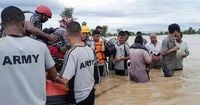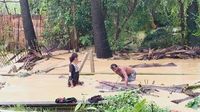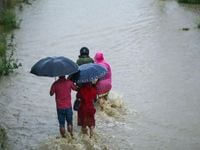As the sun rose over Nepal on October 5, 2025, the country was reeling from one of the deadliest natural disasters in recent memory. Relentless rainfall, starting late on October 4, had unleashed a wave of destruction in the form of landslides, floods, and even lightning strikes, leaving entire communities devastated and officials scrambling to respond. By Sunday evening, the official death toll had climbed to at least 52, with dozens more injured or missing and thousands displaced from their homes. The eastern district of Ilam, nestled in the lush hills of Koshi Province, bore the brunt of the disaster, reporting a staggering 37 fatalities—entire families swept away as mud and debris thundered down the slopes in the dead of night.
The scale of the tragedy was confirmed by Nepal Police and the National Disaster Risk Reduction and Management Authority (NDRRMA), which reported that 50 districts across the country were affected by the extreme weather. In addition to Ilam, the districts of Udayapur and Khotang each recorded two deaths, Panchthar reported eight, and Rautahat saw three fatalities due to flooding. The devastation extended beyond the loss of life: at least five people remained missing as of Sunday afternoon, while 16 were reported injured. In Sunsari district, rising water levels in the Koshi River system inundated more than 1,000 homes, forcing residents to seek shelter in temporary refuges. Floodwaters also reached critical infrastructure, with the Janodaya Basic School and Cardio Neuro Hospital in Bhokraha among those affected. Armed Police Force personnel used boats to ferry doctors to the hospital, underscoring the severity of the crisis.
"There is some damage, but thanks to the authorities' prior flood alert, we were able to move some belongings to a safe place," said Rajan Khadga, a 38-year-old vegetable seller from Kathmandu, in an interview with AFP. His words echoed the sentiment of many Nepalis who, while grateful for early warnings, found themselves confronting the raw power of nature. The government’s disaster response was swift but hampered by the sheer scale of the destruction. Rescue workers, including the Nepal Army and police, launched operations in the hardest-hit zones, but their efforts were stymied by blocked highways, washed-out roads, and continued rainfall. Even helicopters and motorboats, deployed to reach stranded villagers, faced difficulties navigating the treacherous terrain and poor visibility.
In the capital city of Kathmandu, the impact of the heavy rains was felt acutely. Rivers swelled, flooding settlements along their banks and prompting the Kathmandu Metropolitan City (KMC) to initiate a massive cleanup operation. According to Deputy Superintendent Min Bahadur Thapa of the City Police Force, 100 workers, three JCBs, three jet machines, and several dumpers were deployed to clear mud and debris from hard-hit areas like Balkhu, Teku, and the Bishnumati corridor. The work was slow going, with highly saturated mud stalling progress in some locations. Authorities planned to resume operations when weather conditions improved.
Travel across Nepal ground to a halt as the disaster unfolded. All domestic flights were grounded on October 4 due to poor visibility and adverse weather, stranding hundreds of travelers—many of whom were returning home after celebrating the Hindu festival of Dashain, the country’s biggest annual holiday. Major highways connecting Kathmandu to other regions were either swept away by landslides or closed as a precaution, leading to massive traffic jams and leaving numerous communities cut off from the outside world. The government declared Sunday and Monday as public holidays, advising citizens to avoid travel unless absolutely necessary.
In Ilam, the situation was particularly dire. Chief District Officer Sunita Nepal confirmed to local media that 37 people had died in the district, including six members of the same family who were killed when a landslide crushed their home as they slept. Rescue teams struggled to reach remote villages, with many roads either blocked or completely washed away. "Rescue operations are challenging due to blocked roads and difficult terrain," Sunita Nepal told AFP. The government deployed helicopters to evacuate people in need of urgent medical attention, while ground troops assisted in relocating others to safer areas.
The disaster’s toll went beyond immediate casualties. According to the NDRRMA, at least 285 people have died in various disaster-related incidents across Nepal since mid-April 2025, with 27 still missing and more than 1,000 injured in 4,065 separate events. The monsoon, which usually begins in June and ends by mid-September, lingered unusually late this year, keeping the risk of further hazards high. The Department of Hydrology and Meteorology (DHM) announced on Sunday that the low-pressure system responsible for the latest deluge had moved out of the country, but cautioned that the monsoon season was not officially over and urged the public to remain vigilant.
Neighboring India, which surrounds landlocked Nepal on three sides, also felt the effects of the storm and offered support. Indian Prime Minister Narendra Modi took to social media to express his condolences and offer assistance, stating, "We stand with the people and Government of Nepal in this difficult time. As a friendly neighbor and first responder, India remains committed to providing any assistance that may be required." The gesture was welcomed by many in Nepal, though the government had yet to issue an official response as of Sunday evening.
For many Nepalis, the disaster brought back painful memories of previous monsoon tragedies. Last year, similar floods and landslides killed 224 people and left 158 injured. The frequency and severity of such events have raised concerns about the country’s vulnerability to climate change, deforestation, and inadequate infrastructure in rural areas. The government has pledged to improve early warning systems and invest in more resilient infrastructure, but for now, much of the population remains at the mercy of the elements.
Despite the overwhelming challenges, stories of resilience and solidarity emerged from the chaos. In Sunsari, residents worked together to evacuate their neighbors, while in Kathmandu, volunteers joined municipal workers in clearing debris. The Nepal Army and police continued search and rescue operations in high-risk areas, with teams on standby as the government monitored the situation closely. Authorities urged everyone to stay away from rivers and vulnerable slopes, warning that the risk of further landslides and flooding would persist until the monsoon season officially ended.
As the skies cleared and the immediate danger subsided, Nepal began the long process of recovery and rebuilding. The scars left by the disaster—both physical and emotional—will take time to heal, but the strength and resilience of the Nepali people shone through in the face of adversity.


